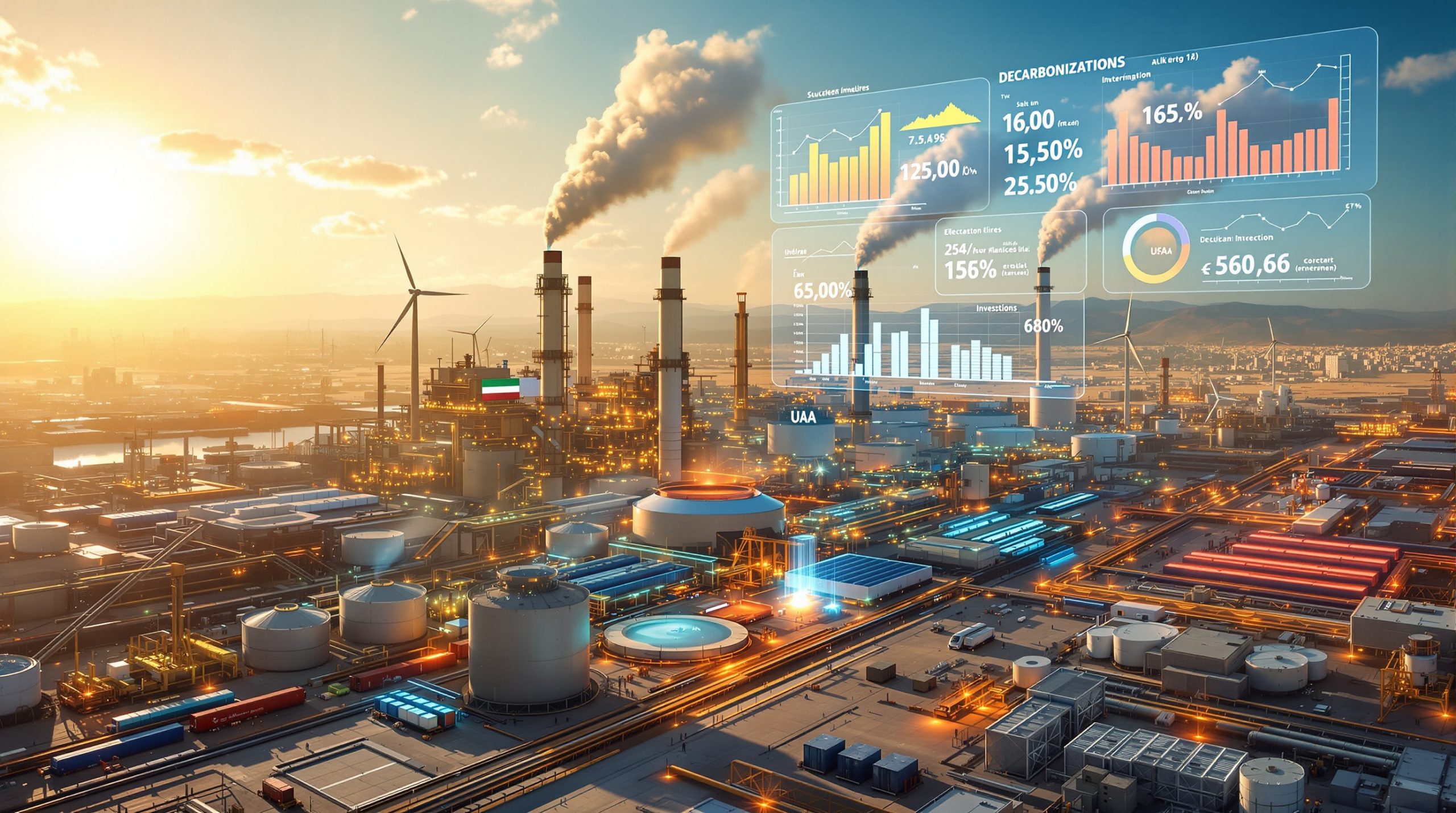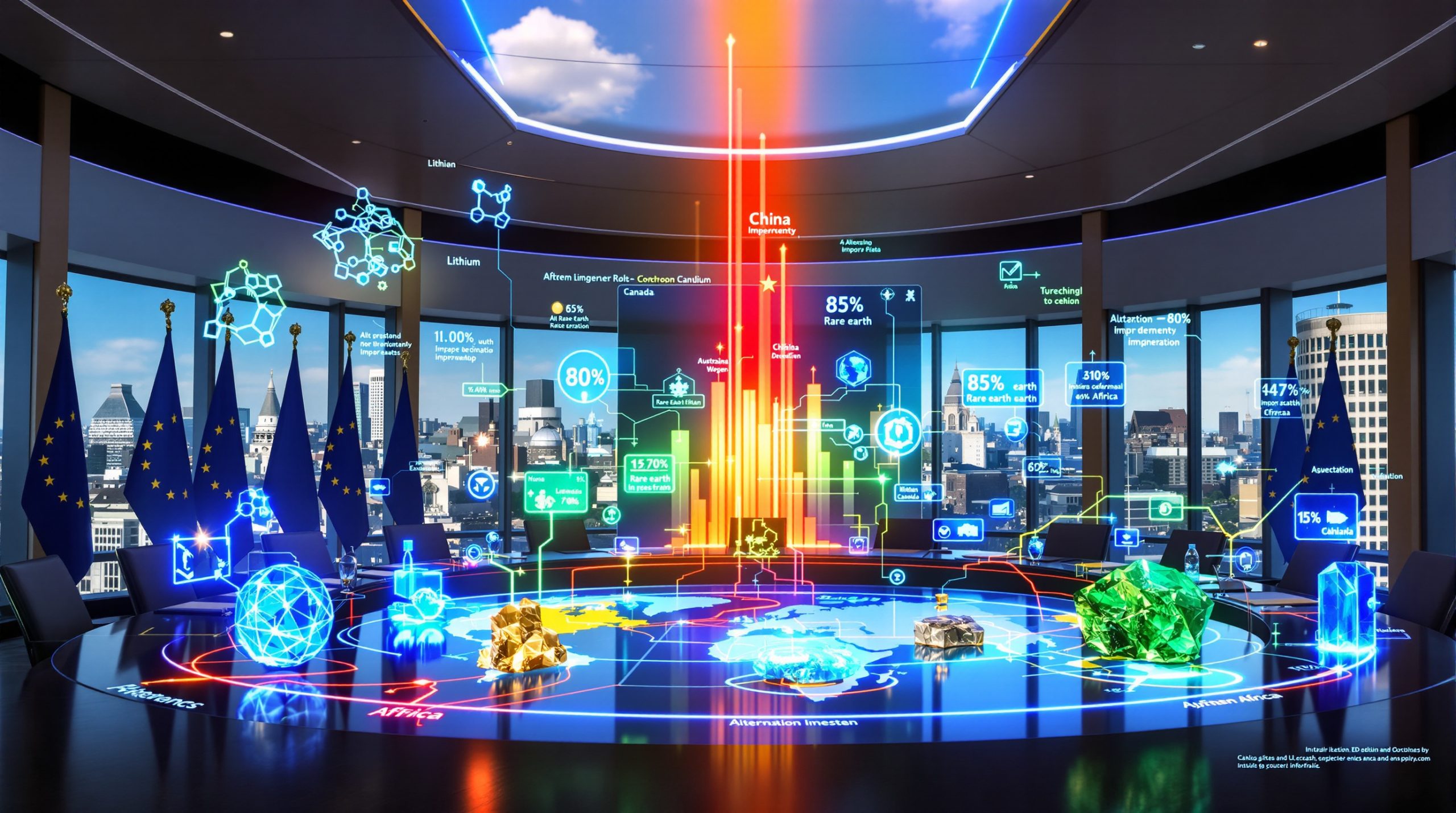The global steel industry stands at a critical inflection point where traditional production methods face unprecedented pressure from environmental regulations and shifting market dynamics. As carbon pricing mechanisms proliferate across major economies, regional steel producers must navigate complex technology transitions while maintaining competitive positioning. The MENA steelmakers decarbonization strategy represents a transformative approach that extends beyond regulatory compliance, encompassing fundamental shifts in production methodology, supply chain integration, and strategic market positioning.
The Middle East and North Africa region emerges as a unique case study in this industrial evolution, possessing inherent advantages through abundant natural gas resources and established direct reduced iron infrastructure. Yet the pathway toward sustainable steel production requires more than resource endowments, demanding coordinated technological deployment, policy framework development, and substantial capital investment across multiple production pathways.
Market Pressures Reshaping MENA Steel Production Landscape
The implementation of the European Union's Carbon Border Adjustment Mechanism on January 1, 2026, fundamentally alters competitive dynamics for MENA steelmakers. This regulatory framework creates both opportunities and challenges, rewarding producers with lower carbon intensity while penalising those dependent on high-emission production methods.
According to industry executives at the 28th Middle East Iron and Steel Conference in Dubai, MENA producers possess structural advantages through natural gas-based direct reduced iron production, which inherently generates lower greenhouse gas emissions compared to coal-dependent blast furnace operations. Michael Rion, Chief Commercial Officer at Emirates Steel, emphasised that while MENA steelmakers benefit from lower carbon emissions profiles, success requires strategic product mix adjustments to align with European market specifications.
The economic implications prove significant yet manageable. Analysis presented by Rafic Daou, Vice Chairman and Managing Director at Suez Steel, indicates that green steel implementation adds approximately $200 per tonne of rebar or $10 per square metre in housing construction costs. These premiums represent minimal impact relative to total construction expenses, yet create substantial competitive differentiation opportunities for early adopters.
CBAM Compliance Creating Regional Competitive Advantages
MENA's natural gas infrastructure provides strategic positioning for CBAM compliance, particularly as provisional benchmarks align with market expectations for steel products. The region's established DRI production methodology inherently produces lower Scope 1 and Scope 2 emissions compared to integrated blast furnace-basic oxygen furnace routes prevalent in other regions.
Key competitive factors include:
- Lower baseline emissions: Natural gas-based DRI operations typically produce 1.2-1.5 tonnes CO2 equivalent per tonne of steel versus 1.8-2.2 tonnes for coal-based integrated operations
- Infrastructure readiness: Existing DRI-EAF production chains require minimal modification for CBAM reporting requirements
- Geographic positioning: Proximity to European markets reduces transportation emissions and logistics complexity
- Resource availability: Abundant natural gas reserves support transition toward hydrogen-based reduction processes
Regional producers must expand product portfolios beyond commodity steel grades to capture European market premiums. Furthermore, this strategic shift requires investment in downstream processing capabilities and quality certification systems aligned with European technical standards.
Production Capacity Distribution and Carbon Intensity Baselines
MENA steel production methodology concentrates heavily on electric arc furnace operations fed with direct reduced iron, creating inherent carbon intensity advantages. The region's 45-46% share of global DRI production reflects technological specialisation that positions these producers favourably for future carbon pricing mechanisms, particularly as iron ore market trends continue to evolve.
Current production methodologies across major MENA markets demonstrate varying carbon intensities:
| Production Route | Typical CO2 Intensity (kg/tonne) | MENA Market Penetration | Decarbonisation Potential |
|---|---|---|---|
| Natural Gas DRI-EAF | 1,200-1,500 | 70-80% | High |
| Scrap-based EAF | 400-600 | 15-20% | Very High |
| Integrated BF-BOF | 1,800-2,200 | 5-10% | Moderate |
The concentration of DRI-EAF production creates opportunities for incremental decarbonisation through hydrogen substitution and renewable energy integration, requiring lower capital investment compared to complete production route changes necessary in coal-dependent regions.
Technology Pathways Driving MENA Steelmakers Decarbonization Strategy
Regional steel producers pursue multiple parallel decarbonisation pathways, recognising that no single technology solution addresses all production requirements and market demands. The strategic approach involves portfolio diversification across hydrogen integration, electric arc furnace optimisation, and carbon capture implementation.
Hydrogen Integration Transforming Steel Chemistry
Green hydrogen represents the most promising long-term decarbonisation pathway for MENA steel producers, leveraging regional renewable energy potential and existing DRI infrastructure. Hydrogen-based direct reduction can achieve 95% carbon intensity reduction compared to natural gas-based processes, creating premium product positioning for export markets.
Dilip George, Group Chief Executive Officer of Foulath Holding, outlined strategic objectives to establish comprehensive low-carbon steel value chains over the next decade. This vision builds upon existing pelletising expertise while incorporating hydrogen reduction technology at industrial scale.
Technical implementation requires several critical components:
- Green hydrogen production: Electrolysis capacity powered by renewable energy sources
- Furnace modifications: DRI shaft furnace adaptations for hydrogen gas chemistry
- Storage infrastructure: Hydrogen compression and storage systems for continuous operation
- Safety systems: Enhanced monitoring and emergency response protocols for hydrogen handling
Investment requirements for hydrogen-DRI conversion range from $800-1,200 per tonne of annual capacity, with return on investment timelines extending 8-12 years depending on carbon pricing mechanisms and green steel market premiums. Consequently, successful implementation requires careful integration with broader renewable energy integration strategies.
Electric Arc Furnace Deployment and Scrap Integration
Electric arc furnace expansion across UAE, Saudi Arabia, and North African markets creates opportunities for immediate carbon intensity reductions while supporting circular economy principles through increased scrap steel utilisation. EAF operations consume 400-600 kWh per tonne of crude steel compared to 1,400-2,000 kWh per tonne for integrated blast furnace routes.
Strategic considerations for EAF deployment include:
- Renewable energy integration: Grid stability requirements for continuous high-power draw operations
- Scrap supply chains: Regional scrap availability and collection infrastructure development
- Product quality control: Maintaining steel chemistry specifications with variable scrap inputs
- Operational flexibility: Capacity to process both scrap and high-quality DRI feedstock
Harsha Shetty, CEO at Jindal Steel Oman, emphasised regional market focus with goals to sell 100% of steel output within the Middle East over the next decade. This strategy requires extended downstream development and integrated value chain optimisation to serve diverse regional demand specifications.
Investment requirements for EAF installation typically range $400-600 per tonne of annual capacity with shorter payback periods of 5-8 years, making this technology pathway more accessible for immediate implementation.
Carbon Capture Integration as Complementary Technology
Carbon capture, utilisation, and storage (CCUS) technology serves as complementary decarbonisation pathway rather than primary solution for MENA steelmakers. CCUS implementation addresses emissions from processes that cannot be eliminated through fuel switching or energy efficiency improvements.
Technical implementation involves:
- Post-combustion capture: CO2 separation from flue gas streams using amine-based solvents
- Geological storage: Underground injection into suitable rock formations with long-term containment
- Industrial utilisation: CO2 conversion into chemicals, fuels, or building materials
- Monitoring systems: Continuous verification of storage integrity and environmental compliance
CCUS investment requirements range $200-400 per tonne of capacity with extended payback periods of 10-15 years, making economic viability dependent on carbon pricing mechanisms and government policy support.
Government Policy Frameworks Supporting Industrial Transformation
Regional government support varies significantly across MENA markets, with some jurisdictions providing comprehensive decarbonisation frameworks while others maintain policy development gaps that create investment uncertainty. These variations significantly impact energy transition strategies across different national contexts.
Regulatory Development Across Regional Markets
The UAE demonstrates advanced policy development with 100% clean electricity targets for industrial sectors, creating regulatory certainty for steel producers planning renewable energy integration. This framework supports long-term capital investment decisions while providing clear compliance pathways.
Saudi Arabia presents contrasting regulatory maturity, with Sharjeel Azhar, CEO at Al-Ittefaq Steel, noting that the kingdom currently lacks specific decarbonisation guidelines despite being a major regional steel producer. This regulatory gap creates investment uncertainty and delays technology deployment decisions.
Key policy requirements for successful decarbonisation include:
- Emission reporting standards: Standardised methodologies for carbon intensity measurement and verification
- Carbon pricing mechanisms: Tax or cap-and-trade systems creating financial incentives for emission reductions
- Technology incentives: Subsidies, tax credits, or accelerated depreciation for green steel equipment
- Trade protection: Anti-dumping measures protecting domestic low-carbon producers from high-carbon imports
Rafic Daou emphasised decarbonisation as generational responsibility, stating that environmental stewardship represents an obligation to future generations beyond regulatory compliance requirements.
Sovereign Investment in Green Steel Infrastructure
Government investment in supporting infrastructure proves critical for successful steel industry decarbonisation. Required infrastructure investments include:
- Renewable energy capacity: Grid-scale solar and wind installations dedicated to industrial consumption
- Hydrogen production facilities: Electrolysis plants with sufficient capacity for industrial hydrogen demand
- Transportation infrastructure: Pipeline networks and storage facilities for hydrogen distribution
- Skills development programmes: Workforce training for new technology operation and maintenance
Public-private partnership models enable risk sharing between government entities and private steel producers, accelerating technology deployment while managing financial exposure. These partnerships typically involve government investment in shared infrastructure while private companies fund production equipment.
Value Chain Strategies and Market Positioning
MENA steelmakers pursue value chain diversification strategies to capture higher margins while reducing commodity price exposure. These approaches emphasise downstream processing capabilities and regional market integration, particularly as broader industry innovation trends reshape competitive dynamics.
Product Portfolio Diversification for Premium Markets
European market access requires alignment with specific technical specifications and environmental certifications beyond basic CBAM compliance. Premium steel grades command significant price premiums while requiring advanced metallurgical capabilities and quality control systems.
Strategic product development focuses on:
- High-strength steel grades: Automotive and construction applications requiring superior mechanical properties
- Corrosion-resistant products: Specialised alloys for marine and chemical processing industries
- Precision-rolled products: Tight dimensional tolerances for manufacturing applications
- Certified low-carbon steel: Environmental verification for green building and sustainable infrastructure projects
These premium segments typically command 15-25% price premiums compared to commodity steel grades while requiring modest additional processing investment.
Regional Supply Chain Optimisation
Hot-briquetted iron (HBI) export strategies versus finished product manufacturing present strategic trade-offs between capital investment and value capture. Raw material exports generate limited value addition while finished products create employment and capture processing margins.
Integrated regional supply chains offer several advantages:
- Logistics optimisation: Reduced transportation costs through regional production and consumption alignment
- Inventory management: Just-in-time delivery capabilities reducing working capital requirements
- Quality control: Integrated quality assurance from raw materials through finished products
- Employment generation: Skilled workforce development supporting broader economic diversification
Regional trade integration requires coordinated infrastructure development and harmonised technical standards across national boundaries. However, implementing the comprehensive MENA steelmakers decarbonization strategy necessitates careful coordination across these various supply chain elements.
Leading Companies Implementing Decarbonisation Strategies
Major MENA steel producers demonstrate varying approaches to decarbonisation implementation, reflecting different market positioning, resource availability, and strategic priorities.
Emirates Steel's Multi-Pillar Approach
Emirates Steel implements comprehensive decarbonisation strategy encompassing multiple technology pathways simultaneously. This diversified approach reduces technology risk while positioning the company for various market scenarios.
Key strategic elements include:
- Clean electricity transition: Integration with UAE's renewable energy grid development
- CBAM compliance preparation: Product certification and reporting system development
- Technology partnerships: Collaboration with international technology providers for hydrogen and CCUS deployment
- Market diversification: Balanced domestic and export market strategy
Saeed Ghumran Al Remeithi, Group CEO at Emirates Steel, emphasises sustainability as core business strategy rather than regulatory compliance exercise.
Saudi Arabia's Mega-Project Development
Saudi Arabian steel development involves large-scale integrated projects leveraging the kingdom's energy resources and sovereign investment capabilities. These developments target multi-million tonne production facilities with hydrogen-ready infrastructure from initial construction.
Strategic advantages include:
- Scale economies: Large production volumes reducing unit costs for advanced technology deployment
- Integrated energy supply: Direct connection to renewable energy projects and hydrogen production facilities
- Export orientation: Strategic positioning for Asian and European market access
- Technology leadership: First-mover advantages in commercial-scale hydrogen steel production
Timeline for hydrogen replacement of natural gas extends over 10-15 year implementation periods, allowing gradual technology maturation and supply chain development.
Cross-Regional Technology Partnerships
International technology partnerships accelerate knowledge transfer while sharing development costs and risks. These collaborations typically involve:
- Joint venture structures: Shared ownership of production facilities and technology assets
- Technology licensing agreements: Access to proprietary processes and operational expertise
- Engineering partnerships: Collaborative facility design and construction management
- Market access arrangements: Distribution networks and customer relationships in target markets
Jindal Steel Oman's Middle East market focus strategy exemplifies regional specialisation within global corporate structures, allowing technology and capital access while maintaining regional market expertise.
Investment Requirements and Financial Framework
Successful steel industry decarbonisation requires substantial capital investment across multiple technology pathways, with financing mechanisms critical for implementation feasibility. In addition, understanding the broader decarbonisation economic benefits helps justify these significant investments.
Capital Expenditure Analysis Across Technology Options
Investment requirements vary significantly across decarbonisation technology pathways, with different risk profiles and return characteristics:
| Technology Pathway | Investment Range ($/tonne capacity) | Implementation Timeline | Primary Risk Factors |
|---|---|---|---|
| Hydrogen-DRI Conversion | $800-1,200 | 8-12 years ROI | H2 supply reliability, technology maturity |
| EAF Installation | $400-600 | 5-8 years ROI | Scrap availability, grid stability |
| CCUS Integration | $200-400 | 10-15 years ROI | Storage capacity, regulatory framework |
| Renewable Energy Integration | $300-500 | 6-10 years ROI | Grid infrastructure, weather variability |
Total investment requirements for comprehensive decarbonisation range $1,000-2,000 per tonne of annual production capacity, representing substantial capital commitment for regional producers.
Financing Mechanisms and Risk Management
Green financing instruments provide access to capital while reducing borrowing costs for environmental projects:
- Green bonds: Dedicated financing for environmental projects with preferential interest rates
- Sustainability-linked loans: Interest rate adjustments based on decarbonisation milestone achievement
- Export credit agencies: Government-backed financing for technology imports and international partnerships
- Carbon credit monetisation: Revenue generation from verified emission reductions
Government support mechanisms include:
- Investment tax credits: Direct reductions in corporate tax liability for green technology deployment
- Accelerated depreciation: Faster capital cost recovery for environmental equipment
- Loan guarantees: Government backing reducing financial institution risk and borrowing costs
- Research and development grants: Partial funding for technology development and pilot projects
Global Competitive Positioning and Market Dynamics
MENA steel producers compete within global markets where decarbonisation progress varies significantly across regions, creating both opportunities and challenges for market share expansion.
Comparative Analysis Against Global Steel Industries
Regional positioning assessment reveals mixed competitive dynamics:
Advantages:
- Lower baseline carbon intensity through natural gas-based production
- Abundant renewable energy resources for future hydrogen production
- Proximity to major consumption markets in Europe and Asia
- Established DRI technology expertise and infrastructure
Challenges:
- Limited scrap steel availability requiring continued virgin material dependence
- Higher production costs compared to coal-based operations in some regions
- Technology deployment timeline delays compared to European and Japanese producers
- Smaller production scale relative to Chinese integrated steel complexes
Technology adoption rates across regions show MENA producers maintaining competitive positioning in DRI-EAF methodology while requiring acceleration in hydrogen and renewable energy integration to maintain long-term competitiveness.
Supply Chain Resilience and Geographic Benefits
MENA's geographic positioning provides strategic advantages for global steel trade:
- Market proximity: Reduced transportation costs and delivery times to European and Asian markets
- Raw material access: Established iron ore import logistics from Australia and Brazil
- Energy security: Domestic natural gas production reducing input cost volatility
- Political stability: Relatively stable regulatory environment compared to other emerging market regions
These factors support long-term investment confidence while providing competitive advantages in global market positioning.
Implementation Timeline and Success Scenarios
Steel industry decarbonisation requires coordinated implementation across multiple timelines, with different technology pathways maturing at varying rates. The comprehensive MENA steelmakers decarbonization strategy must account for these temporal variations.
Short-Term Milestones (2025-2030)
Immediate priorities focus on CBAM compliance and foundational infrastructure development:
- CBAM certification processes: Implementation of carbon intensity measurement and reporting systems
- Pilot project deployment: Commercial demonstration of hydrogen-DRI and advanced EAF operations
- Renewable energy integration: Grid connection and power purchase agreements for clean electricity
- Regional collaboration frameworks: Cross-border cooperation agreements for technology sharing
Success metrics include achieving 20-30% carbon intensity reduction by 2030 while maintaining production capacity and market share.
Long-Term Net-Zero Pathways (2030-2050)
Complete decarbonisation requires fundamental transformation of production methodology:
- Full hydrogen transition: Commercial-scale hydrogen-based steel production across major facilities
- Circular economy integration: Maximum scrap steel utilisation and waste stream elimination
- Carbon neutral operations: Net-zero emissions through renewable energy and carbon offset mechanisms
- Technology leadership: Export of decarbonisation technology and expertise to emerging markets
Achievement of net-zero emissions by 2050 aligns with international climate commitments while positioning MENA producers as technology leaders in sustainable steel production.
Risk Assessment and Mitigation Strategies
Multiple risk categories could potentially derail decarbonisation implementation, requiring comprehensive risk management strategies.
Technology and Infrastructure Risks
Primary technical risks include:
- Hydrogen supply chain delays: Insufficient green hydrogen production capacity limiting steel production transitions
- Renewable energy grid instability: Power quality issues affecting EAF operations and hydrogen production
- Skills shortage: Inadequate workforce training for new technology operation and maintenance
- Technology performance shortfalls: Equipment reliability issues or performance below design specifications
Mitigation approaches involve:
- Diversified technology portfolios: Multiple parallel pathways reducing dependence on single solutions
- Phased implementation: Gradual deployment allowing technology maturation and learning curve development
- Strategic partnerships: Risk sharing with technology providers and engineering contractors
- Workforce development programmes: Early investment in skills training and education initiatives
Market and Regulatory Uncertainties
External risks beyond company control include:
- Global steel demand volatility: Economic downturns reducing demand for premium low-carbon products
- Carbon pricing mechanism evolution: Changes in CBAM implementation or carbon tax structures
- International trade policy shifts: New tariffs or trade restrictions affecting export market access
- Commodity price fluctuations: Input cost volatility affecting project economics and investment returns
Risk management strategies encompass:
- Market diversification: Multiple geographic markets reducing dependence on single regions
- Financial hedging: Commodity price and currency risk management through derivatives
- Regulatory engagement: Active participation in policy development processes
- Flexible investment structures: Modular project design allowing adaptation to changing conditions
The successful implementation of the MENA steelmakers decarbonization strategy requires careful navigation of these complex risk factors while maintaining operational excellence and market competitiveness.
This analysis is based on market information available as of November 2025. Steel industry decarbonisation involves significant technological, financial, and regulatory uncertainties. Investment decisions should be based on comprehensive due diligence and professional advice appropriate to specific circumstances.
Further exploration of global steel industry decarbonisation trends is available through comprehensive market analysis and industry sustainability reports, which provide detailed coverage of steel market developments and sustainability initiatives.
Looking to Invest in MENA Steel Companies Leading Decarbonisation?
Discovery Alert's proprietary Discovery IQ model delivers real-time alerts on significant mineral discoveries across the ASX, helping investors identify emerging opportunities in the metals and mining sector that supply global steel production. Start your 30-day free trial today and gain the market-leading advantage needed to capitalise on the evolving steel industry value chain.




